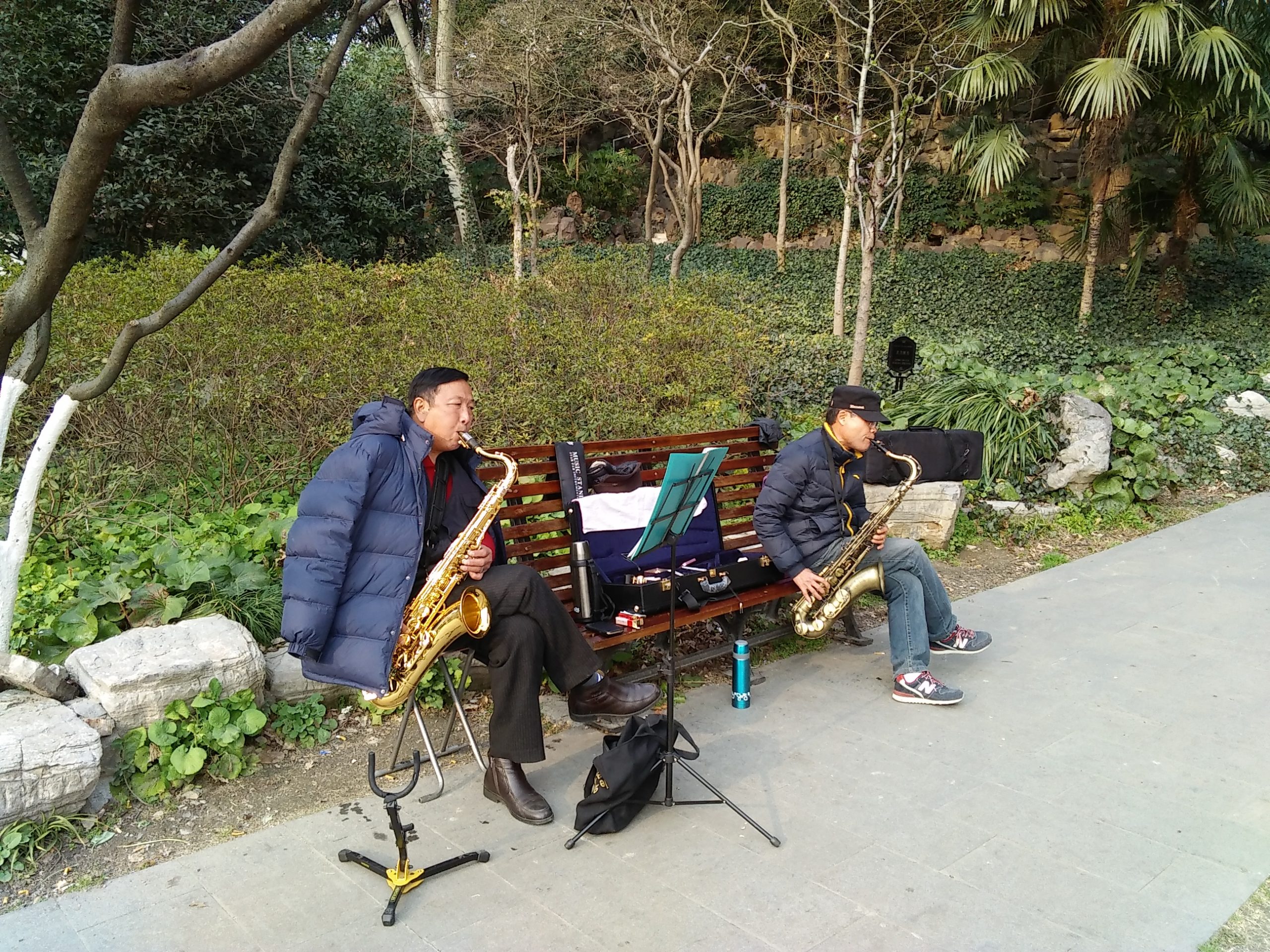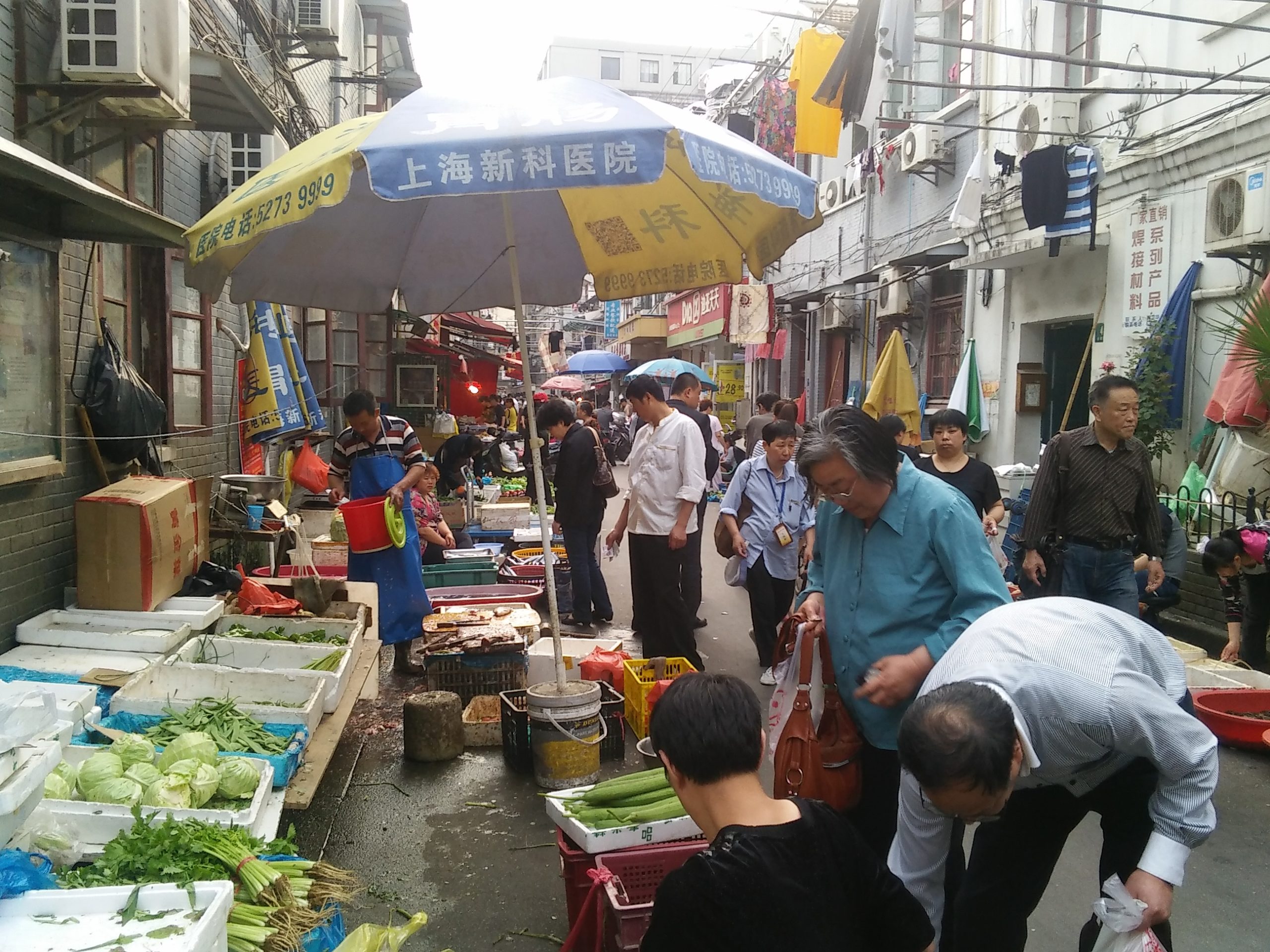
Shanghai is a symphony of sounds, some mellow others discordant, that occcasionally include saxophones in Lu Xun park.
By Diane Hope
It wasn’t the most obvious place to enjoy the delights of Shanghai. I was on one of the pedestrian bridges above a six-lane surface street and beneath the elevated section of the Yan’An freeway at 7pm, the tail end of the evening rush hour. My twenty-something friend Robin was bored, shuffling from foot to foot, checking texts on his Smart phone. “Listen to this!” I shouted, pulled his attention away from the glowing screen. “I’ve found the heartbeat of the city”.
We both stood there for a few seconds, as the tires of the cars on the overpass a few feet above our heads thump thudded their way across joints in the elevated road surface. Then Robin started grinning and gave me a high five – it really did sound like a pulse. At most times of the day and night, Shanghai has a fast and irregular heartbeat.
There are plenty of standout tourist spots in Shanghai – more than enough to fill a two to three-day visit. A stroll along The Bund with its neoclassic architecture and spectacular view across the Huangpu River to Pudong’s Oriental Pearl Tower and bristling brand new skyscrapers. Or a trip to the top of the newest, tallest – and reportedly final – mega skyscraper, the 2,073-ft. Shanghai Tower. Or a visit to one of the many museums or giant shopping malls. But for returning seasoned visitors, and jaded locals looking for a new way to explore, there’s another approach that opens up a completely different side of the city.
Sound tourism rarely is considered an interesting activity. Sounds constantly are absorbed or filtered out subliminally by our brains. Only the loudest or most grating are usually noticed. But while human vision typically only extends to a field of around 160-degrees laterally and 135-degrees vertically, sound is experienced from a full 360-degrees around you. And on that basis places that visually look a bit drab or even ugly can spring to life.
Places like the Middle Sichuan Road – a small but lively street in the central Huangpu district that runs parallel to The Bund. For most tourists, Middle Sichuan Road is just a street you cross on your way up East Nanjing Road. But if cars and trucks on Shanghai’s major road arteries are the city’s heartbeat, then traffic flows along minor streets like this are its lifeblood.
The feature of sonic (as well as visual) interest here is the constant stream of scooting commuters. Unlike Beijing and other cities further north with colder winters, in Shanghai it’s mild enough to ride an electric bike, moped, scooter or motorcycle all year round. And these motorized two-wheelers have almost completely taken over from all but the most impoverished pedal cyclists. Middle Sichuan Rd is one of the most popular streets in the city for this two-wheeled traffic. Indeed, any point from the Yan’An freeway north to Suzhou Creek is a great place to experience the whirring whizzing blur. On wet days the tires on damp roads sound sticky, as if moving through glue.
We’re so used to interpreting our environment visually that acquiring an interest in urban soundscapes takes some practice. It can be a meditation. I recommend one of Shanghai’s Buddhist temples as a great place to start an adventure into the city’s sonic landscapes. Longhua Temple offers superb listening opportunities, along with the obvious visual attractions. The relative calm within the temple walls forms a backdrop within which to hear chanting monks, a clanging of a bell or the sound of whispered prayers floating through the air with the smoke from burning incense. It’s simultaneously exhilarating and calming.
For many people, Shanghai is all about the bustle and chatter of shopping. But if you visit a place like the Wanshang Bird and Insect Market the air throbs with vibrant and intricate sounds. As you approach from the street you’re enveloped in a pulsating chorus of crickets – presented for sale in perpex jars and tiny cardboard boxes. According to Chinese tradition, the soothing chirps of captive crickets promote tranquility and a sense of well-being. Some of the sweetest singing comes from canaries, whose melodies dance across the market in rippling cadenzas. The prize for sheer volume goes to the myna birds, famed for their ability to reproduce sounds including human speech. At the market, you’re most likely to hear them shrieking Gong Xi Fa Cai 恭喜发财 … “wishing you a happy and prosperous New Year”. The market has wild birds. The Chinese画眉 huà-méi or hwamei (‘melodious laughing thrush’) are not native to the Shanghai area, but are captured for their loud, clear song, that has varied whistles as well as imitations of other birds they hear.

In the late afternoon through early evening you can experience the sounds of local life on little lanes like Wufu Alley.
There are sonic rewards in the local street markets just off East Nanjing Road too. In the late afternoon through early evening a couple of short blocks north off the main drag, you can experience the sounds of local life on little lanes like Wufu Alley. From street merchants and customers bantering to the strains of Chinese TV shows leaking from open windows as families gather for dinner. Later on there’s the swish of brooms sweeping up and shutters rattling down as stalls close up. To fully escape the roar of urban traffic venture off the tourist trail into one of the old style Shikumen residential areas and stroll down one of the narrow lilong alleys. Down some of these lanes it’s quiet enough to hear people washing and chopping vegetables for dinner and water trickling down the pipes.
Shanghai is a modern city, a 21st century metropolis on track to become the world’s most dynamic urban area. But you only need to enter one of its many parks to sample a slice of the country’s history in the music to be found. In Lu Xun Park any day of the week you can hear everything from a flute-accordion-erhu trio playing a haunting traditional melody to a vocalist singing a Tibetan folk song, to retired men practicing their chops on the saxophone. There’s even karaoke. Watch and listen for the weird and wonderful whining whirr of people playing with spinning tops, which recreate a sound-effect not unlike the spooky background to a 1950’s sci-fi B-movie.
The fun of touring a vast and vibrant city like Shanghai by half-closing your eyes, once in a while and just listening is that the exact composition and arrangement you’ll hear will vary from day to day, even hour by hour. Every visitor gets his own unique listening experience. My own personal favorites during a four-month stay as an artist-in-residence in the city were the Lunar New Year’s eve fireworks. As midnight approaches, you start to hear deep thunderous rumbles, so powerful they sound almost geologic, advancing down urban canyons with deep echoes. On the stroke of midnight there are street level firecracker ‘storms’ accompanied by rockets firing haphazardly from apartment balconies that sound like a multitude of Chinese dragons roaring. On one of my last days in the city – a glorious sunrise in mid-May on The Bund – two kite fliers out to catch the early morning breezes unraveled a string of foil kites right by my microphones. As the flimsy forms coiled and writhed into the sky it was easy to imagine a dancing flying snake-like beast, whispering and rustling its way across the smoggy Pudong skyline. If you listen carefully enough with just a little imagination, then truly – Here Be Dragons!
_____________
Diane Hope is a PhD audio producer, sound recordist and urban ecologist whose radio feature about the soundscapes of Shanghai, Here Be Dragons, is available at:
http://www.abc.net.au/radionational/programs/soundproof/here-be-dragons/6847616.
Her online audio guide to Shanghai’s central Huangpu district is available in English and Mandarin at: http://www.shanghaisoundsguide.com/

